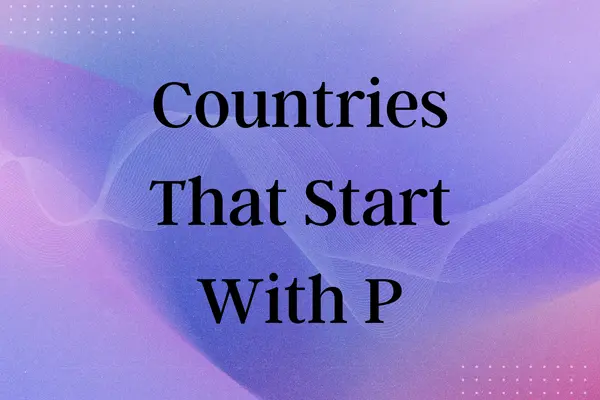Countries That Begins With P – List Of Countries In the World Starts From Letter P
Pakistan
Pakistan is a country located in southern Asia. The region now straddling the border of present–day Pakistan and Afghanistan is one of the most torn regions of the world.

The region has seen the arrival and departure of several civilizations, through invasions and migrations: Alexander’s period, the January Uprising of 1857 by the Sepoys, the establishment of the British Raj, and through to the Partition of British Raj in 1947. Pakistan is bordered by the India–administered Kashmir to the east, Afghanistan to the northwest, and the nation of Iran and the whole of Balochistan to the west.
Philippines
The Philippines is a Southeast Asian country located in the western Pacific Ocean. It is an archipelago that consists of 7,641 islands with a total land area of 300,000 square kilometers.

The Philippines is divided into three major island groups: Luzon, Visayas, and Mindanao. The capital city of the Philippines is Manila and the most populous city is Quezon City.
The official languages of the Philippines are Filipino and English. The population of the Philippines is approximately 104 million people. The majority of the population is Roman Catholic. The currency of the Philippines is the Philippine Peso.
Poland
Poland is a country in Central Europe. It is bordered by Germany to the west, the Czech Republic and Slovakia to the south, Ukraine and Belarus to the east, and Lithuania and Kaliningrad Oblast to the north.

The total area of Poland is 312,679 square kilometers, making it the 69th largest country in the world and the 9th largest in Europe.
Poland has a population of over 38 million people, which makes it the 34th most populous country in the world and the sixth most populous member state of the European Union.
Peru
Peru is a country located in the central and western parts of South America. It is bordered in the north by Ecuador and Colombia, in the east by Brazil, in the southeast by Bolivia, in the south by Chile, and in the southwest by the Pacific Ocean.

Peru covers an area of 1,285,216 km2 and has a population of more than 32 million. The official language of Peru is Spanish, but Quechua and Aymara are also spoken. The capital of Peru is Lima.
Portugal
Portugal lies at the southwest tip of Europe and shares the Iberian peninsula with Spain. Its capital city is Lisbon, which is Portugal’s largest city and main commercial and industrial center. In addition to Lisbon, other major cities in Portugal include Porto, Braga, and Coimbra. Portugal has a total land area of 91,470 square kilometers (35,351 square miles) and a population of just over 10 million people.

Portugal’s climate is temperate and maritime, with average annual temperatures ranging from 12–24 degrees Celsius (54–75 degrees Fahrenheit). The country experiences a fair amount of rainfall, particularly in the north. Portugal’s economy is based primarily on agriculture, fishing, forestry, and manufacturing.
The country is also a leading producer of cork. Tourism is another important industry in Portugal. Some of Portugal’s most popular tourist destinations include Lisbon, Porto, the island of Madeira, and the Algarve region.
Papua New Guinea
Papua New Guinea is a sovereign state in Oceania that occupies the eastern half of the island of New Guinea and its offshore islands in Melanesia, a region of the southwestern Pacific Ocean north of Australia.

Its capital, located along its southeastern coast, is Port Moresby. The western half of New Guinea forms the Indonesian provinces of Papua and West Papua.
At the national level, Papua New Guinea is a unitary parliamentary democracy and constitutional monarchy. The country uses English as its official language, while Tok Pisin and Hiri Motu are also widely spoken. Papua New Guinea is one of the most culturally diverse countries in the world. There are an estimated 848 different languages spoken in the country, of which 11 have no known living speakers.
Paraguay
Paraguay is located in the heart of South America and is bordered by Argentina, Bolivia, and Brazil. As of 2019, the estimated population of Paraguay was 7 million people. The official language of Paraguay is Spanish, however, the native language of Paraguay is Guaraní. The capital city of Paraguay is Asunción, and the currency is the guaraní.

Paraguay is a landlocked country with a tropical climate. The terrain of Paraguay is mostly plains with some hills and woodlands. The economy of Paraguay is based on agriculture, livestock, forestry, and fishing. The main crops grown in Paraguay are soybeans, wheat, corn, and tobacco. Manufacturing and tourism are also important to the Paraguayan economy.
Palestine State

The State of Palestine is a de jure sovereign state in Western Asia claiming the West Bank (a landlocked territory that borders Israel, Jordan, and Egypt) and Gaza Strip (a coastal territory that borders the Mediterranean Sea and Egypt) with East Jerusalem as the designated capital, although its administrative center is currently located in Ramallah. The State of Palestine claims a population of 4,816,503 as of 2016.
Panama
The Republic of Panama is a country located in Central America and it is the southernmost country in North America. The country has an area of 75,517 km2 and a population of over 4 million people.

The country is bordered by Costa Rica to the west, Colombia to the southeast, the Caribbean Sea to the north, and the Pacific Ocean to the south. The capital and largest city are Panama City.
The country is divided into nine provinces and three indigenous territories. The indigenous territories are Kuna Yala, Embera–Wounaan, and Ngobe–Bugle. The country has a tropical climate with an average temperature of 27 degrees Celsius. The official language of Panama is Spanish but there are also many indigenous languages spoken in the country.
Palau
Palau is an island country located in the Western Pacific Ocean. Part of the Micronesia region, it is some 500 miles (800 km) east of the Philippines and 2,000 miles (3,200 km) south of Tokyo. Palau‘s total land area is about 177 square miles (460 km2), and its population was estimated at 21,347 in July 2016.

The most populous island of Palau is Babeldaob, which is also the largest island, and area–wise, the country‘s largest municipality. Palau shares maritime boundaries with the Philippines, Indonesia, and the Federated States of Micronesia.
Join 25,000+ smart readers—don’t miss out!








